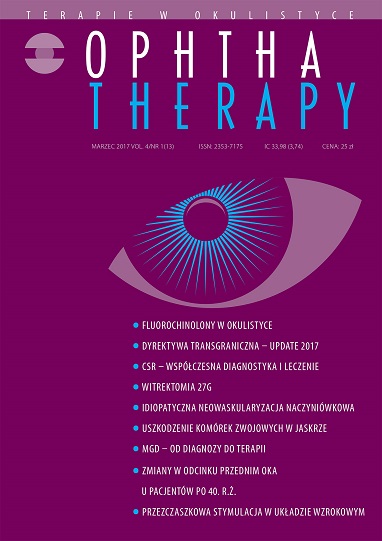Fluorochinolony w okulistyce – głos w dyskusji
##plugins.themes.bootstrap3.article.main##
Abstrakt
Obecnie stosowane w okulistyce fluorowane chinolony są skuteczne w leczeniu zakażeń bakteryjnych przedniego odcinka oka. Efekt terapeutyczny jest zwykle widoczny po 2–3 dniach leczenia, są na ogół dobrze tolerowane przez pacjentów i rzadko powodują reakcje alergiczne. Wybór leku w przypadku wspomnianych zakażeń nie zawsze jest łatwy, nawet gdy jesteśmy prawie pewni etiologii bakteryjnej infekcji. Bierzemy pod uwagę postać stanu zapalnego sugerującą tę etiologię, odczucia pacjenta, zakres działania przeciwbakteryjnego leku oraz już znane lub poznawane na etapie terapii: nadwrażliwość na składniki leku, informacje z pracowni mikrobiologicznej co do rodzaju bakterii występujących na danym obszarze i ich oporności na antybiotyk, a także stan pacjenta i jego gotowość do przestrzegania zaleceń lekarza.
Pobrania
##plugins.themes.bootstrap3.article.details##

Utwór dostępny jest na licencji Creative Commons Uznanie autorstwa – Użycie niekomercyjne – Bez utworów zależnych 4.0 Międzynarodowe.
Copyright: © Medical Education sp. z o.o. License allowing third parties to copy and redistribute the material in any medium or format and to remix, transform, and build upon the material, provided the original work is properly cited and states its license.
Address reprint requests to: Medical Education, Marcin Kuźma (marcin.kuzma@mededu.pl)
Bibliografia
2. Hooper DC, Wolfson JS. The fluoroquinolones: pharmacology, clinical uses, and toxicities in humans. Antimicrob Agents Chemother. 1985; 28(5): 716-21.
3. Deschênes J, Blondeau J. Besifloxacin in the management of bacterial infections of the ocular surface. Can J Ophthalmol. 2015; 50(3): 184-91.
4. Park HS, Lee JH, Kim HK. Comparative clinical study of conjunctival toxicities of newer generation fluoroquinolones without the influence of preservatives. Int J Ophthalmol. 2015; 8(6): 1220-3.
5. Dowell SF, Schwartz B, Phillips WR. Appropriate use of antibiotics for URIs in children: Part II. Cough, pharyngitis and the common cold. The Pediatric URI Consensus Team. Am Fam Physician. 1998; 58(6): 1335-42, 45.
6. Cohen FL, Tartasky D. Microbial resistance to drug therapy: a review. Am J Infect Control. 1997; 25(1): 51-64.
7. Baquero F. Evolving resistance patterns of Streptococcus pneumoniae: a link with long-acting macrolide consumption? J Chemother. 1999; 11 Suppl 1: 35-43.
8. Scoper SV. Review of third-and fourth-generation fluoroquinolones in ophthalmology: in-vitro and in-vivo efficacy. Adv Ther. 2008; 25(10): 979-94.
9. Huz JI, Mukkamala K, Pagan IR, et al. Clinical outcomes and antibiotic susceptibilities of Staphylococcus aureus endophthalmitis. Graefes Arch Clin Exp Ophthalmol. 2016. https://doi.org/10.1007/s00417-016-3504-x.
10. Papa V, Blanco AR, Santocono M. Ocular flora and their antibiotic susceptibility in patients having cataract surgery in Italy. J Cataract Refract Surg. 2016; 42(9): 1312-7.

